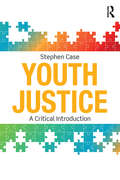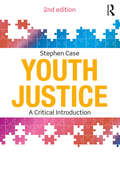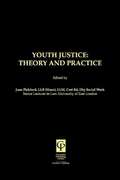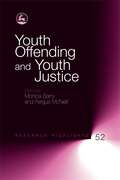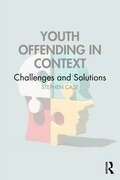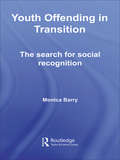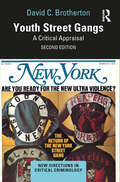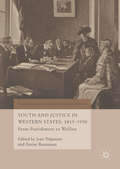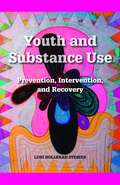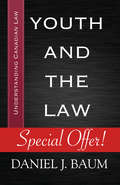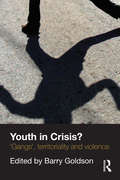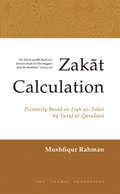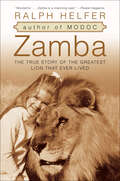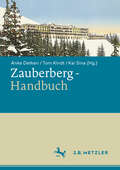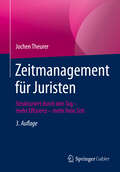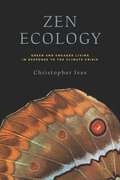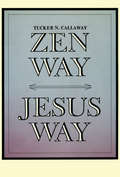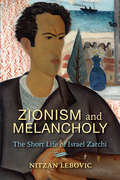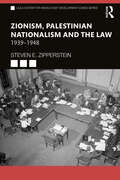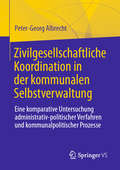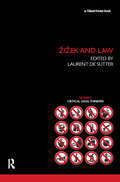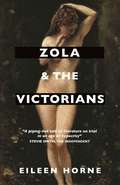- Table View
- List View
Youth Justice: A Critical Introduction
by Stephen CaseThis book provides a comprehensive, student-friendly and critical introduction to youth justice in England and Wales, offering a balanced evaluation of its development, rationale, nature and evidence base. It explores the evolution of definitions and explanations of youth offending and examines the responses to it that constitute youth justice. Bringing together theory and practice, this book provides a balanced exposition of contemporary youth justice debates, including detailed discussions of governmental rationales and practical issues and an extensive evaluation of critical academic positions. It includes a range of features designed to engage and inspire students: ‘Stop and think’: Activities challenging students to reflect on important issues. ‘Conversations’: Discussions of key themes and issues from the perspectives and experiences of relevant stakeholders, including policy makers and activists. ‘Telling it like it is’: Testimonies giving voice to the personalised, subjective and contentious viewpoints of youth justice influencers. ‘Controversies and debates’: Prompts to stimulate students to question and critique established knowledge and understanding by considering alternative angles. ‘Recurring theme alerts’: Boxes flagging up recurring themes in the developing construction of youth offending and youth justice. This book is essential reading for students taking courses in youth justice, youth offending, youth crime, youth work and social policy.
Youth Justice: A Critical Introduction
by Stephen CaseThis book provides a comprehensive, student-friendly and critical introduction to youth justice in England and Wales, offering a balanced evaluation of its development, rationale, nature and evidence base. It explores the evolution of definitions and explanations of youth offending and examines the responses to it that constitute youth justice. Bringing together theory, policy and practice, this book provides a balanced exposition of contemporary youth justice debates, including detailed discussions of governmental rationales, policy developments, practical issues and an extensive evaluation of critical academic positions. It includes a range of features designed to engage and inspire students: ‘Stop and think’: Activities challenging students to reflect on important issues. ‘Conversations’: Discussions of key themes and issues from the perspectives and experiences of relevant stakeholders, including policy makers and activists. ‘Telling it like it is’: Testimonies giving voice to the personalised, subjective and contentious viewpoints of youth justice influencers. ‘Controversies and debates’: Prompts to stimulate students to question and critique established knowledge and understanding by considering alternative angles. ‘Recurring theme alerts’: Boxes flagging recurring themes in the developing construction of youth offending and youth justice. The new edition has been fully revised and updated and includes discussion of revised National Standards in Youth Justice, the new ‘Child First’ strategic objective for youth justice, the ‘trauma informed practice’ movement, the impact of coronavirus on children in the Youth Justice System and the continued impact of austerity on policy and practice. This book is essential reading for students taking courses in youth justice, youth offending, youth crime, youth work and social policy.
Youth Justice: Theory & Practice
by Jane PickfordThis innovative text examines contemporary issues in youth justice in the light of the sweeping reforms introduced by the Crime and Disorder Act 1998 and the Youth Justice and Criminal Evidence Bill 1999. It brings together current debates in both the practice and theory of youth justice intervention and, in the light of the governments inter-agency approach to the problem of youth criminality, provides an inter-disciplinary examination of these discussions. Including contributions from both academics, magistrates and social work practitioners, it is a useful text for students of criminology, law and social work, as well as a valuable resource for youth justice practitioners.
Youth Offending and Youth Justice
by Fergus Mcneill Monica BarryHow is the modern world shaping young people and youth crime? What impact is this having on the latest policies and practice? Are current youth justice services working? With contributions from leading researchers in the field, this book offers an insightful, scholarly and critical analysis of such key issues. Youth Offending and Youth Justice engages constructively with current policy and practice debates, tackling issues such as the criminalisation and penalisation of youth, sentencer decision-making, the incarceration of young people and the role of public opinion. It also features an applied focus on professional practice. Drawing on a wide range of high-quality research, this book will enrich the work of practitioners, managers, policy-makers, students and academics in social work, youth work, criminal justice and youth justice in the UK and beyond.
Youth Offending in Context: Challenges and Solutions
by Stephen CaseIdentifying and exploring the challenges in understanding and responding to youth crime, this book investigates the different contexts which contribute to youth offending as well as those which either help or hinder effective youth justice responses to it.Supporting readers to evaluate traditional understandings and responses to youth offending, this critical, evidence-based text engages with a variety of international case studies, practice examples and expert perspectives from academic researchers in the field. Delving into theoretical, conceptual, empirical, policy and practice issues, Youth Offending in Context will be of great value to students of youth justice, youth offending, youth crime, crime prevention, and criminal justice.
Youth Offending in Transition: The Search for Social Recognition
by Monica BarryTaking a new approach to youth crime, this book argues that the transition from childhood to adulthood can be an isolating and disempowering experience for young people. Children and young people are inherently vulnerable because of their age and status – they are a minority group, with the potential for being exploited, discriminated against, dominated and disrespected by adults. Youth Offending in Transition explores how their treatment by adult society may lead young people to resort to crime as a means of gaining respect from their peers. Using concepts of capital and the narratives of young offenders themselves, this book is based on original research into the reasons why young people start and stop offending. It discusses the following topics: criminal theory and the significance of youth transitions to the ‘age-crime curve’ social identity and reputation amongst young people social inequalities and their influence on youth transitions the criminalization and discrimination of young people by adults the importance of social recognition in reducing offending.
Youth Street Gangs: A Critical Appraisal (New Directions in Critical Criminology)
by David C. BrothertonGangs have been heavily pathologized in the last several decades. In comparison to the pioneering Chicago School's work on gangs in the 1920s we have moved away from a humanistic appraisal of and sensitivity toward the phenomenon and have allowed the gang to become a highly plastic folk devil outside of history. This pathologization of the gang has particularly negative consequences for democracy in an age of punishment, cruelty and coercive social control.This is the central thesis of David Brotherton’s celebrated book on street gangs. Drawing on a wealth of highly acclaimed original research, Brotherton explores the socially layered practices of street gangs, including community movements, cultural projects and sites of social resistance. The book also critically reviews gang theory and the geographical trajectories of streets gangs from New York and Puerto Rico to Europe, the Caribbean and South America, as well as state-sponsored reactions and the enabling role of orthodox criminology. In opposition to the dominant gang discourses, Brotherton proposes the development of a critical studies approach to gangs and concludes by making a plea for researchers to engage the gang reflexively, paying attention to the contradictory agency of the gang and what gang members actually tell us.This new edition has been revised and fully updated, containing three new chapters offering alternative approaches to interventions in gang violence, and to gang desistance, drawing on detailed interviews with Antonio Fernandez (King Tone), former head of the Latin Kings. The book is essential reading for academics and students involved in the study of juvenile delinquency, youth studies, deviance, gang studies and cultural criminology.
Youth and Justice in Western States, 1815-1950: From Punishment To Welfare (World Histories of Crime, Culture and Violence)
by Xavier Rousseaux Jean TrépanierThis book explores the treatment of junevile offenders in modern Western history. The last few decades have witnessed major debates over youth justice policies. Juvenile and youth justice legislation has been reviewed in a number of countries. Despite the fact that new perspectives, such as restorative justice, have emerged, the debates have largely focused on issues that bring us back to the inception of juvenile justice: namely whether youth justice ought to be more akin to punitive adult criminal justice, or more sensitive to the welfare of youths. This issue has been at the core of policy choices that have given juvenile justice its orientations since the beginning of the twentieth century. It also gave shape to the evolution that paved the way for the creation of juvenile courts in the nineteenth century. Understanding those early debates is essential if we are to understand current debates, and place them into perspective. Based on primary archival research, this comprehensive study begins by presenting the roots, birth and evolution of juvenile justice, from the nineteenth century up to the beginning of the twenty-first. The second part deals with nineteenth century responses to juvenile delinquency in England and Canada, while the third focuses on the welfare orientation that characterized juvenile courts in the first half of the twentieth century in Switzerland, the Netherlands, Germany and Belgium. Finally, the fourth part focuses on the perspective of the youths and their families in Belgium, France and Canada.
Youth and Substance Use: Prevention, Intervention, and Recovery
by Lori Holleran SteikerThis book translates the best of what we know from research and practice into a "how to" book--how to understand, how to interact and intervene, how to maximize your impact, and how to transform societal perceptions beyond your practice. Although numerous texts address substance misuse in general, this book allows specializing undergraduates, graduate students, and practitioners to acquire knowledge and skills related to substance misuse specifically among youth populations.
Youth and the Law
by Daniel J. BaumReal cases from the Supreme Court dealing with youth issues. Laws, as they relate to youth and youth issues, can be difficult to understand for those they are intended to serve. In the first book of the Understanding Canadian Law series, author Daniel J. Baum breaks down the Supreme Court of Canada’s decisions relating to youth in plain language intended for readers of all ages. Drawing on examples from recent Supreme Court rulings, Youth and the Law walks the reader through such controversial subjects as spanking, bullying, youth violence, and police in the schools. Each chapter contains prompts to encourage critical thinking. Youth and the Law is an objective introduction for all readers to better understand how law impacts the young.
Youth in Crisis?: 'Gangs', Territoriality and Violence
by Barry GoldsonFew issues attract greater concern and censure than those that surround youth 'gangs'. Paradoxically, youth researchers have conventionally been reluctant to even use the term 'gang' but, more recently, such reluctance has receded. Indeed, it is increasingly claimed that – in particular urban 'territories' – youth gangs are commonplace, some young people are deeply immersed in violence and the carrying and use of weapons (particularly knives and firearms) is routine. Comprizing a series of essays from leading national and international researchers, this book subjects such claims to rigorous critical scrutiny. It provides a challenging and authoritative account of complex questions pertaining to urban youth identities, crime and social order. This book: locates the question of 'gangs' in both historical and contemporary contexts engages a spectrum of theoretical perspectives and analytical positions presents and analyzes cutting-edge empirical research addresses a range of previously neglected questions, including those pertaining to girls, young women and 'gangs'. Youth in Crisis? provides a vital resource for researchers, educators, policy-makers and practitioners with an interest in key questions facing criminology, sociology and social policy.
Zakat Calculation
by Yusuf Al-Qaradawi Mushfiqur RahmanThis guidebook is an excellent reference for average readers on the concept, objectives, nature and principles underlying zakat (charity) in Islam.
Zamba: The True Story of the Greatest Lion That Ever Lived
by Ralph HelferBy the author of Modoc:A famed trainer’s “wonderful” memoir of his bond with a lion—and his quest to change how animals were treated in Hollywood (People).When Ralph Helfer, author of Modoc and one of Hollywood’s top animal behaviorists, first began working, he was shocked by the cruelty that was accepted practice in the field. He firmly believed in “affection training”—that love, not fear, should be the basis of any animal’s development, even when dealing with the most dangerous of creatures. Then Zamba came into his life—an adorable four-month-old lion cub that went on to prove Helfer’s theories resoundingly correct.Over the next eighteen years, Zamba would thrive and grow, and go on to star in numerous motion pictures and television shows, all the while developing a deep and powerful bond of love and affection with the man who raised him. By turns astonishing, hilarious, and poignant, Zamba is the unforgettable story not only of the relationship that Helfer would come to consider one of the most important in his life but also of the amazing career and adventures of the greatest lion in the world.“Many stories, both humorous and touching . . . a fascinating book.” —School Library Journal“A warmhearted tale of love between two species.” —Booklist“Extraordinary.” —Kirkus ReviewsIncludes photographs
Zauberberg-Handbuch
by Tom Kindt Anke Detken Kai SinaThomas Manns „Der Zauberberg“ (1924) ist ein Meisterwerk der Romankunst und ein Hauptbeitrag der deutschsprachigen Literatur zur internationalen Moderne. Das Handbuch stellt Grundlageninformationen über Entstehung und Form des Romans zusammen, analysiert Themen, Strukturen und Gattungstraditionen, informiert über die weit verzweigte Rezeption und stellt exemplarisch neuere Forschungszugänge dar. Inhaltliche Schwerpunkte bilden die brisanten politischen Implikationen des Romans und seiner Genese, die programmatische Intertextualität sowie die Internationalität der „Zauberberg“-Rezeption.
Zeitmanagement für Juristen: Strukturiert durch den Tag - mehr Effizienz - mehr freie Zeit
by Jochen TheurerDieses Buch stellt Zeitmanagement-Strategien speziell für Juristen und Rechtsanwälte, Steuerberater und Wirtschaftsprüfer vor. Diese Berufsgruppen, die Standesregeln oder hohem wirtschaftlichen Druck ausgesetzt sind, klagen häufig über Zeitprobleme. Doch die üblichen Ratschläge zum Thema Zeitmanagement helfen ihnen aufgrund der besonderen beruflichen Anforderungen meist nicht weiter. Zudem sind die Zeitprobleme so individuell, dass eine „allgemeine“ Strategie nicht passt. Hier setzt dieses Buch an: Es vermittelt Juristen und Rechtsanwälten, Steuerberatern und Wirtschaftsprüfern das Wissen und erläutert die Werkzeuge, um selbständig Strategien für ihre persönlichen Zeitprobleme zu entwickeln und diese erfolgreich in ihrem beruflichen Alltag umzusetzen. Die überarbeitete 3. Auflage wurde um goldene Regeln zur sinnvollen Strukturierung des Arbeitstags, effiziente Arbeitstechniken für Textprogramme, Tipps für effektiveres Kommunizieren und ein Kapitel über schnelleres Lesen (Speed Reading) erweitert.
Zeitmanagement für Juristen: Strukturiert durch den Tag - mehr Effizienz - mehr freie Zeit
by Jochen TheurerDieses Buch stellt Zeitmanagement-Strategien speziell für Juristen und Rechtsanwälte, Steuerberater und Wirtschaftsprüfer vor. Diese Berufsgruppen sind Standesregeln und hohem wirtschaftlichen Druck ausgesetzt und klagen häufig über Zeitprobleme. Doch die üblichen Ratschläge zum Thema Zeitmanagement helfen ihnen aufgrund der besonderen beruflichen Anforderungen meist nicht weiter. Zudem sind die Zeitprobleme so individuell, dass eine „allgemeine“ Strategie nicht passt. Hier setzt dieses Buch an: Es vermittelt Juristen und Rechtsanwälten, Steuerberatern und Wirtschaftsprüfern das Wissen und die Werkzeuge, um selbstständig Strategien für ihre persönlichen Zeitprobleme zu entwickeln und diese erfolgreich in ihrem beruflichen Alltag umzusetzen. Die überarbeitete 4. Auflage wurde um Erfahrungen aus der Corona-Pandemie und ein Kapitel über Gesundheit und Körper erweitert.
Zen Ecology: Green and Engaged Living in Response to the Climate Crisis
by Christopher IvesDiscover a way of living that can help you slow down and stay grounded—and at the same time reduce your ecological impact and engage more fully with the climate crisis.It may seem as though living ecologically and engaging in activism sacrifices our own enjoyment and happiness on the altar of doing the right thing. In this book, professor, naturalist, and Buddhist author Christopher Ives offers an alternative: a way of living that can actually be more fulfilling than the modern consumerist lifestyle. Rather than deprivation, it can bring us richness. In Zen Ecology, Chris outlines his environmental ethic as a series of concentric circles, beginning with ourselves and then moving outward into our communities, all the while focusing on spaciousness, mindfulness, generosity, and contentment. At the individual level, we deal with distraction, clutter, and ecological harm. Here, Chris offers ways to help us pay attention, simplify our lives, and lower our impact. Then, we explore how to envision our home as a &“place of the Way,&” with Zen monastic life as a model for this—without having to be a monk! Next, we realize our embeddedness in nature and emplace ourselves in community with others, including other forms of life. Finally, we build on this basis to engage in activism to create a world that is more supportive of ecological health and spiritual fulfillment. In this way, we avoid the two extremes of apathy and burnout, and uncover a way of living that is simple, joyful, embedded in nature, connected to others in community, and supportive of collective action.
Zen Way - Jesus Way
by Tucker N. CallawayThis groundbreaking book successfully fuses the two overlapping traditions of Zen Buddhism and Christianity.Very few Christians who are interested in Zen Buddhism understand the fundamentals of the religion itself. <P><P>Most of the books which are available on Zen are superficial and fraught with caricatures and erroneous generalizations - concentrating more on meditation than on the real essence of Zen. Now the Christian who has been waiting for a clear and thorough explanation of Zen in terms he can understand has been provided with Zen Way--Jesus Way--a unique inside look at Christianity and Zen Buddhism by Dr. Tucker N. Callaway, a committed Christian missionary who for twenty years has practiced zazen in Japanese temples in an effort to reach the heart of the faith.Calloway has a knack for making philosophical concepts clear to the general reader and begins Zen Way--Jesus Way by presenting the fundamental presuppositions of Zen and several of the concepts which are logically deduced from them. Next he relates some of his experiences in Buddhist temples, while explaining the practical applications of Zen philosophy. Finally he interprets the Jesus Way in a manner that makes possible a genuine comparison with the Zen way.
Zionism and Melancholy: The Short Life of Israel Zarchi (New Jewish Philosophy and Thought)
by Nitzan LebovicNitzan Lebovic claims that political melancholy is the defining trait of a generation of Israelis born between the 1960s and 1990s. This cohort came of age during wars, occupation and intifada, cultural conflict, and the failure of the Oslo Accords. The atmosphere of militarism and conservative state politics left little room for democratic opposition or dissent. Lebovic and others depict the failure to respond not only as a result of institutional pressure but as the effect of a long-lasting "left-wing melancholy." In order to understand its grip on Israeli society, Lebovic turns to the novels and short stories of Israel Zarchi. For him, Zarchi aptly describes the gap between the utopian hope present in Zionism since its early days and the melancholic reality of the present. Through personal engagement with Zarchi, Lebovic develops a philosophy of melancholy and shows how it pervades Israeli society.
Zionism, Palestinian Nationalism and the Law: 1939-1948 (UCLA Center for Middle East Development (CMED))
by Steven E. ZippersteinDuring the last decade of the British Mandate for Palestine (1939–1948), Arabs and Jews used the law as a resource to gain leverage against each other and to influence international opinion. The parties invoked "transformational legal framing" to portray the essentially political-religious conflict as a legal dispute involving claims of justice, injustice, and victimisation, and giving rise to legal/equitable remedies. Employing this form of narrative and framing in multiple "trials" during the first 15 years of the Mandate, the parties continued the practice during the last and most crucial decade of the Mandate. The term "trial" provides an appropriate typology for understanding the adversarial proceedings during those years in which judges, lawyers, witnesses, cross-examination, and legal argumentation played a key role in the conflict. The four trials between 1939 and 1947 produced three different outcomes: the one-state solution in favour of the Palestinian Arabs, the no-state solution, and the two-state solution embodied in the United Nations November 1947 partition resolution, culminating in Israel's independence in May 1948. This study analyses the role of the law during the last decade of the British Mandate for Palestine, making an essential contribution to the literature on lawfare, framing and narrative, and the Arab-Israeli Conflict.
Zivil- und strafrechtliche Unternehmensverantwortung für Menschenrechtsverletzungen (Interdisziplinäre Studien zu Menschenrechten #1)
by Markus Krajewski Franziska Oehm Miriam Saage-MaaßVerknüpfung von völkerrechtlichen Normen mit Haftungsfragen im nationalen Zivil- und Strafrecht.<P><P> Vergleichender Blick in ausländische Zivilrechtsordnungen.<P> Umfasst einen Bericht aus anwaltlicher Praxis über Verfahren gegen Unternehmen wegen Menschenrechtsverletzungen vor nationalen Gerichten.<P> Der Band enthält Untersuchungen zu zivil- und strafrechtlichen Konsequenzen unternehmerischen Handelns bei Menschenrechtsverletzungen. Im Zentrum stehen dabei deutsches Zivil-, Handels- und Internationales Privatrecht sowie deutsches und internationales Strafrecht. Hinzu treten Analysen des englischen und US-amerikanischen Haftungsrechts. Die Beiträge dieses Bandes fassen den aktuellen Forschungs- und Diskussionsstand zusammen und zeigen sowohl rechtspolitische Handlungsmöglichkeiten als auch weiteren Forschungsbedarf auf. Die in dem Band erörterten und analysierten Fragen sind zugleich als Ausgangspunkt und Referenzrahmen für ein besseres Verständnis und eine Weiterentwicklung des Zusammenhangs von Wirtschaft und Menschenrechten.
Zivilgesellschaftliche Koordination in der kommunalen Selbstverwaltung: Eine komparative Untersuchung administrativ-politischer Verfahren und kommunalpolitischer Prozesse
by Peter-Georg AlbrechtKommunale Selbstverwaltung lässt sich allein weder institutionen-affin noch wettbewerbswirtschaftlich-freiheitlich oder kritisch-emanzipatorisch verwirklichen. Der Band analysiert ausgewählte Verfahren und Prozesse in der kommunalen Bau-, Wirtschafts- und Sozialpolitik sowie Ordnungs- und Sicherheitspolitik. Er gibt Empfehlungen für kommunalpolitische Akteure und Verwaltungsleitungen, die auf Basis eines Konzepts der zivilgesellschaftlichen Koordination handeln wollen. Die interessierte Leserin und den interessierten Leser erwarten eine detailreiche Einführung, ein breiter Überblick sowie eine dichte Beschreibung verschiedener Verfahren, Prozesse und Handlungsfelder.
Zivilisationsrettung jetzt!: Ein Manifest zum klimasolidarischen Grundeinkommen
by Brüne SchloenDieses Buch vermittelt gegen die aktuellen Verwerfungen durch den Ukraine-Krieg und angesichts des sich abzeichnenden Auseinanderfallens der Weltwirtschaft in autokratische und demokratische Blöcke eine Positivbotschaft. Letztere setzt auf ein engeres, solidarisches Zusammenrücken zur Abwendung der uns alle bedrohenden Klimaapokalypse. Den Problemlösungsschlüssel dafür bildet eine menschenwürdigere und ganzheitlichere Sozial-, Wirtschafts- und Umweltpolitik in größeren als bisher jemals gedachten Umverteilungsdimensionen. Allein über ein dafür noch rechtzeitiges Aufwachen von Führungseliten, veröffentlichter Meinung und letztendlich wandlungsbereiter Bevölkerung sieht der Autor Chancen für eine hoffnungsbegründende Zivilisationsrettung. Derartige Rettungschancen können nur aus überzeugenden Vorteilserzählungen auf der Grundlage einer ganzheitlichen Wandlungsstrategie erwachsen. Dazu müssen solche Erzählungen sowohl konkret sein wie auch als umsetzbar vermittelt werden. Den Schlüssel dafür soll der vorgestellte Plan für ein klimasolidarisches Grundeinkommen liefern. Nur über dieses lassen sich noch rechtzeitig Problemlösungen gegen Klimakatastrophe und Gesellschaftszerfall auf den Weg bringen.
Zizek and Law (Nomikoi: Critical Legal Thinkers)
by Laurent De SutterThe very first book dedicated to Slavoj Zizek’s theoretical treatment of law, this book gathers widely recognized Zizek scholars as well as legal theorists to offer a sustained analysis of the place of law in Zizek’s work. Whether it is with reference to symbolic law, psychoanalytical law, religious law, positive law, human rights, to Lacan’s, Hegel’s, or Kant’s philosophies of law, or even to Jewish or Buddhist law, Zizek returns again and again to law. And what his work offers, this volume demonstrates, is a radically new approach to law, and a rethinking of its role within the framework of radical politics. With the help of Zizek himself – who here, and for the first time, directly engages with the topic of law – this collection provides an authoritative account of ‘Zizek and law’. It will be invaluable resource for researchers and students in the fields of law, legal theory, legal philosophy, political theory, psychoanalysis, theology, and cultural studies.
Zola and the Victorians: Censorship in the Age of Hypocrisy
by Eileen HorneLondon, 1888: Jack the Ripper stalks the streets of Whitechapel; national strikes and social unrest threaten the status quo; a grave economic crisis is spreading across the Atlantic . . . Yet Her Majesty's government is preoccupied with "a mere book" - or rather, a series of books: new translations of the Rougon-Macquart saga by French literary giant Émile Zola.In his time, Zola made his British contemporaries look positively pastoral; much of his work is considered shocking and transgressive even now. But it was his English publisher who bore the brunt of the Victorians' moral outrage at Zola's "realistic" depictions of striking miners, society courtesans and priapic, feuding farmers.Seventy years before Lady Chatterley's Lover broke the back of British censorship, Henry Vizetelly's commitment to publishing Zola, and to the nascent principle of free speech, not only landed him in the dock and thereafter in prison, but brought to ruin to the publishing house he had founded. Meanwhile, Zola was going from strength to strength, establishing his reputation as a literary legend and falling in love with a woman half his age.This lively, humorous and ultimately tragic tale is an exploration of the consequences of translation and censorship which remains relevant today for readers, publishers and authors everywhere.
